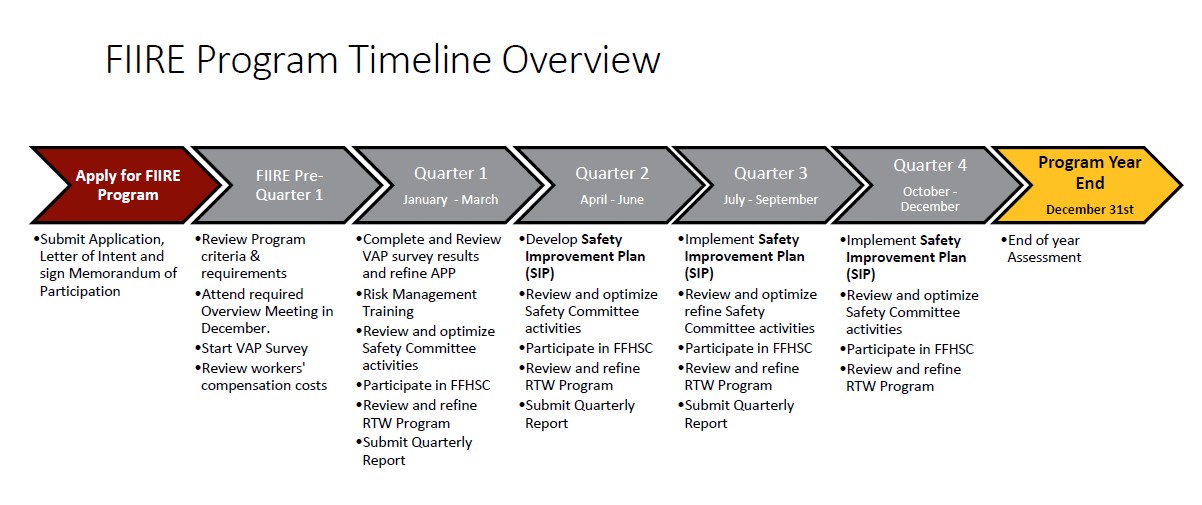FIIRE Program Requirements
Fire Departments that participate in the FIIRE Program will be eligible for a premium rate reduction of 10% for risk class 6904. They can also apply for equipment grants during the application period.
Fire Departments that did not participate in FIIRE the prior year must review their worker’s compensation costs and assess their safety and health programs using the Vulnerability Assessment Program (VAP) survey.
During the first year of participation, all Fire Departments commit to:
Letter of Intent
- Make a decision regarding participation in the FIIRE Program in coordination with the department’s fire chief, designated union official, and jurisdictional authority.
- Decision to participate in the FIIRE Program:
- Submit a Letter of Intent signed by the department’s fire chief, designated union official, and jurisdictional authority.
- Submit an Application and sign a Memorandum of Participation
- Decision to participate in the FIIRE Program:
Re-Enrollment
- Departments that wish to continue in the program at the conclusion of the first year of participation must submit a newly signed memorandum of participation annually.
Withdrawal
- Decision to withdraw from the FIIRE Program:
- Submit letter declining participation, including information on the basis for decision and signature of those that enrolled the department into the program.
Self-assessment
- Assess the Fire Department's safety and health programs using the Vulnerability Assessment Program (VAP) survey results.
- Share the VAP results with Union Representative and Jurisdictional Authority.
- Refine their Accident Prevention Program (APP) and other policies and procedures based on VAP results.
Strengthen safety committee
- Strengthen safety committees by participating in L&I provided proactive risk management training to improve the ways in which hazards are assessed and mitigated.
- Optimize safety committee activities based on training, including applying proactive risk management principles to hazard identification, incident investigations, and injury/near-miss reporting.
Safety Improvement Plan
- Develop and implement a tailored Safety Improvement Plan (SIP) that integrates self-assessment results, risk management training, and safety and health best practices to address carcinogen exposures and musculoskeletal disorders such as those related to patient transport and equipment handling.
- Actively monitor and adjust the SIP for effectiveness.
Return to Work Programs
- Develop plans to incorporate Return to Work, including consideration of the Stay at Work incentive program, to improve outcomes for injured fire fighters and mitigate time-loss costs to the department.
Firefighter Health and Safety Collaborative
- Participate in the Firefighter Health and Safety Collaborative .
Quarterly Reporting
- Submit three quarterly progress reports and an end of year report to L&I.
Timeline
Open the timeline to see the overview.

About the FIIRE Grant Program
The Firefighter Injury and Illness Reduction (FIIRE) Grant Program awards grants to employers of firefighters to purchase additional equipment or gear to implement safety and health best practices. The grant program is part of the FIIRE Program safety initiative to reduce incidence of firefighter occupational injuries and illnesses through proactive risk management and implementation of best practices.
A key requirement of the FIIRE Program is the development and implementation of a Safety Improvement Plan (SIP). Each fire department’s SIP will be based on self-assessment results, risk management training, and safety and health best practices to address carcinogen exposures and work-related musculoskeletal disorders.
The FIIRE Grant Program, provides funding to FIIRE Program participants to purchase equipment or gear to help them implement their SIP. The funds can be used to purchase equipment or gear used to mitigate exposure to carcinogens or work-related musculoskeletal disorders.
Use the resources on this page as you participate in the FIIRE Program. For general information about fire fighting health and safety, see our fire fighting industry page.
Accident Prevention Program
- Accident Prevention Plan (APP) template
- Getting started with Safety & Health
- Sample Safety Programs & Plans
Carcinogen Reduction Best Practices
- Healthy In, Healthy Out, Best Practices for Reducing Fire Fighter Risk of Exposures to Carcinogens
- Best Practice Considerations: Carcinogen Exposure Reduction
Musculoskeletal Injury Prevention
- FF / EMS Musculoskeletal Injury Prevention On-Duty Fitness Best Practices
- Patient Transport Best Practices: Mechanical chest compression devices may be beneficial when prolonged CPR is required
- Patient Transport Best Practices: Power stretchers and power loaders are a cost effective way to prevent injuries
- Patient Transport Best Practices: Priority Recommendations
- Patient Transport Best Practices: Stair chairs with tracks can save your back
Return to Work Program/Policies
- Washington Fire Chiefs’ Time-loss Resources
- Return to Work Toolkit
- RTW Webinars
- Help Your Employee Return to Work
- Washington Fire Chiefs’ Return to Work Guide for Injured Firefighters (adobe.com)
Safety Committee
- Safety Committees and Meetings
- Safety Video - Safety Meetings : Give 'em What They Want
- Safety Health Workshops
- WFC Training Resources
Vulnerability Assessment Program (VAP)
For more assistance, attend a virtual Safety & Health workshop, or contact DOSH Consultation for free assistance with building your APP, risk management, and other safety & health needs.